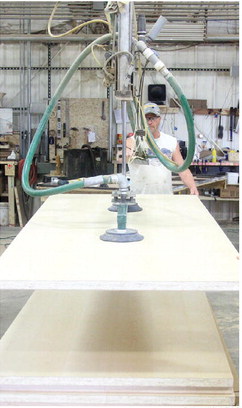Protect Doors


_________
veneer. It once did a door for an amusement park in
Continued from page 3
which it had to place a peephole in an eyeball design.
“We can make any of our doors using virtually any sustainably harvested wood species,” Johnson said.
With that focus on detail comes some extra design time on orders. Johnson and other designers run computer drafting programs to create the look of an order before the craftsmen on the floor go to work.
“We can do whatever an architect can dream up,” Johnson said. “Architects love to put their marks on things.”
As such, there’s also nothing at Protect Door that can be made in a fast-paced, automated assembly-line fashion. In Spencer, an average order involves two employees taking two weeks to do everything to exacting specifications.
“Our jobs are more of the craftsmanship type of job,” Deiler said. “We have very tight tolerances. We’re talking one-thirty-second of an inch or less a lot of times.”
Another door product that’s been growing in popularity lately is a sound-buffering product. Those are used for music rooms to keep sound in, or on buildings near airports, to keep noise out. Rooms in which confi dential discussions take place also require specialty doors designed with sound in mind.
Yet another niche product is the anti-ligature door. Those are used in mental health facilities, and are of a design that prohibits a patient from attempting to commit suicide by hanging themselves. It’s not a common door to make, but as Johnson says, “Somebody’s gotta do it.”
Such a variety of door designs/models mean workers don’t get bored making the same thing every day.
“Everything we make is a one-off,” Johnson said. “There’s nothing that’s vanilla. Virtually everything we make is made one-off and it’s made by hand. Our people like that.”
While Deiler said it’s a priority for his company to expand its product line so one product can pick up the slack if sales of others slip, he also knows it’s important for Protect Door to retain its reputation for its ability to respond rapidly to customer needs. As an example, the company recently got a rush order on a hospital building project in South Carolina, and was able to ship 16 doors to the site within four days.
“Our niche is doing things fast and being able to react to customers’ needs really quickly,” Deiler said.
While Johnson and Deiler know some of their doors are as close to home as hospitals in Neillsville, Marshfi eld and Wisconsin Rapids, others wind up in places they don’t even know. They often ship to distribution centers with the final location of the building projects never revealed. It is world-wide, though, such as an order of Protect Door’s products that recently went to a large medical complex in Qatar.
And all those doors come from a non-descript plant along Highway 13 in Spencer. There are no huge signs, and the company rarely gives public tours because of proprietary information. It’s a small plant with a focus on a specific market.
“Everything we build is in the architectural field but it’s special,” Johnson said. “It’s the stuff the largevolume door plants don’t want to slow down their processes with.”

Built with lead-line panels or of a combination of wood layers, Protect Door’s products weigh more than typical doors but are built to exact specificiations so they appear and close like regular doors.DEANLESAR/TRG
